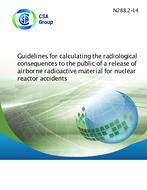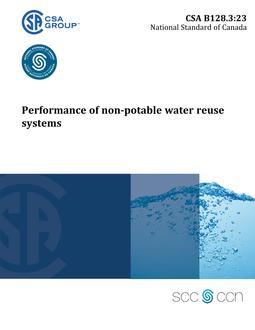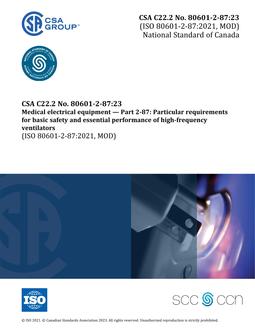
CSA N288.2-14
Preface
This is the second edition of CSA N288.2, Guidelines for calculating the radiological consequences to the public of a release of airborne radioactive material for nuclear reactor accidents. It supersedes the previous edition published in 1991 under the title Guidelines for calculating radiation doses to the public from a release of airborne radioactive material under hypothetical accident conditions in nuclear reactors. This Standard is part of a series of Standards on environmental management for nuclear facilities. This Standard describes acceptable methods for modelling the consequences of accidents at nuclear reactors for safety assessment and real-time emergency response. This Standard also identifies acceptable data sources and acceptable methodologies to account for specific effects, and recommends standardized end points for the calculations. This edition has been updated to reflect current industry practice and new research and analysis methods. Major changes to this edition include a) updating definitions and terminology in accordance with current usage; b) incorporation of new guidance from relevant national and international publications that address doses from accidental releases (e.g., new ICRP guidance on dose coefficients); c) broadening the applicability to include assessments that are conducted for licensing, emergency planning, or environmental assessment purposes; d) provision of guidance on consequence assessments for emergency response during a real event; e) inclusion of all radionuclides that could be released to the atmosphere in a postulated or real accident; f) allowance for a stochastic treatment of meteorological data in which doses are calculated for many records in the meteorological archives at a given site; g) discussion of the uncertainty in the dose estimates; h) provision of guidance on how to obtain the meteorological information required by the models (e.g., stability class) and performance requirements for data measurement; i) inclusion of health risks resulting from the predicted doses (including organ doses for deterministic effects); j) consideration of approaches to account for time-dependent releases to the environment; k) provision of guidance on the location and age of the representative person for whom doses are calculated; l) advanced methods for treating the release of tritium; m) provision of guidance on how to determine individual doses from stochastic results consistent with regulatory expectations for conservative analysis; and n) provision of guidance on the attributes that atmospheric dispersion computer codes should consider for use in the Canadian regulatory context. Users of this Standard are reminded that the site selection, design, manufacture, construction, installation, commissioning, operation, and decommissioning of nuclear facilities in Canada are subject to the Nuclear Safety and Control Act and its Regulations. The Canadian Nuclear Safety Commission might impose additional requirements to those specified in this Standard. The CSA N-Series Standards provide an interlinked set of requirements for the management of nuclear facilities and activities. CSA N286 provides overall direction to management to develop and implement sound management practices and controls, while the other CSA Group nuclear Standards provide technical requirements and guidance that support the management system. This Standard works in harmony with CSA N286 and does not duplicate the generic requirements of CSA N286; however, it may provide more specific direction for those requirements.
Introduction
0.1 Previous edition The previous edition of this Standard provided guidance on modelling postulated accidents at nuclear power plants. It was used to demonstrate compliance of the design with licensing requirements that were expressed in terms of dose to a critical individual located at the site boundary. The previous edition used a straight-line Gaussian dispersion model that calculated concentration in the air and on the ground surface. The previous edition also calculated effective dose and equivalent dose to thyroid for the estimation of stochastic health effects. This effectively limited the previous edition to design basis accidents at nuclear power plants, which required demonstration that the effective dose was less than 250 mSv. The previous edition of the Standard described equations and parameters that were to be used to calculate the doses to an individual. The selected equations and parameters were closely associated with an implementation of the Standard in the code PEAR (Public Exposures from Accidental Releases). Since then, the PEAR code has been superseded by a new software called ADDAM (Atmospheric Dispersion and Dose Analysis Method) and the Canadian nuclear industry has adopted other code packages created by the U.S. government [such as MACCS2 (Melcor Accident Consequence Code Systems)] and the European Union [COSYMA (Code System from MARIA – Methods for Assessing the Radiological Impact of Accidents)] for estimating the consequences of postulated accidents. For emergency response, the ERP (Emergency Response Plan) series of codes designed by Ontario Power Generation (OPG) and Emergency Management Ontario (EMO) have been used alongside the RODOS (Real-time On-line Decision Support) and ARGOS (Accident Reporting and Guidance Operational System) codes from the European Union. 0.2 Evolution of methodology Since the publication of the previous edition, the range of accidents that are routinely modeled includes beyond-design-basis-accidents and severe accidents. The radioactivity released during these postulated accidents can potentially expose individuals to doses that exceed the threshold for deterministic health effects, including early death from radiation syndrome. In this context, calculating the committed effective dose is not sufficient to assess the health effects to individuals. Another important factor concerns the methodology for the analysis of severe accidents, which uses probabilistic safety assessment (PSA) methods. These methods proceed by identifying initiating events and the frequency of postulated end-states (such as core melt) using fault-tree methods. The thermohydraulic behaviour of the system during accident progression is then modelled to arrive at a source term, the activity released to the atmosphere. The last step, which is the focus of this edition, consists hourly meteorological data. Furthermore, there has been broad interest in modelling real-time accidents for emergency response purposes. In this last context, the models use current or forecast meteorological data and measured or estimated source terms to calculate the consequences for individuals living near a nuclear power plant. 0.3 Industry review Several industry reviews of the previous edition of this Standard identified gaps and areas for improvement. The reviews recognized the need to broaden the type of consequence assessments to include those conducted for licensing, emergency planning, or environmental assessment purposes. There was also a need for guidance on consequence assessments for emergency response during a real event. It was felt that the theoretical models themselves needed to be reviewed to better reflect current knowledge in the field. Finally, numerical methods and data have evolved over the last twenty years. The ICRP has published new guidance on dose coefficients and the reviews recommended that these changes be incorporated into the new edition. 0.4 New edition The new edition does not mandate a single approach or code, or provide detailed equations to construct a code. It describes acceptable methods that can be used to calculate the consequences of a nuclear accident. The new edition also identifies acceptable data sources and acceptable methodologies to account for specific effects, and recommends standardized end points for the calculations. Once the user has chosen a specific code, the user should obtain the equations and parameter values required to calculate doses and other end points from the code documentation. The clauses of this Standard start with the treatment of meteorology, including the statistical sampling of meteorological parameters (Clause 4). Source characterization is discussed in Clause 5 and dispersion in the atmosphere in Clause 6. The calculation of consequences such as ground contamination and dose assessment for stochastic and deterministic health effects is addressed in Clause 7. Uncertainty assessment is covered in Clause 8. Informative guidance is provided in the Annexes.
Scope
1.1 Type of consequence assessments This Standard proposes methods for modelling the consequences of accidents at nuclear reactors for safety assessment and real-time emergency response. Notes: 1) Models used to assess the consequences of a postulated accident for safety assessment purposes have much in common with those used for a real-time nuclear accident for emergency response purposes, including the calculation of dispersion and air concentrations. However, the two types of models differ in their treatment of source terms and end points. 2) Safety assessment is a prospective activity that includes a) deterministic and probabilistic calculations carried out for licensing purposes; b) probabilistic risk assessment for cost-benefit analyses; and c) deterministic and probabilistic calculations carried out for emergency planning purposes. 3) Emergency response consequence assessment is carried out during a real emergency in support of the protection of the public and the environment. Emergency planning consequence assessment is performed forpostulated accidents in support of preparedness activities such as locating reception centres for evacuees and training emergency responders. 1.2 Facilities This Standard is designed to provide guidance on how to model the consequences of accidental radiological releases to the atmosphere from nuclear reactor facilities. When using this Standard with facilities other than nuclear reactors, the user is instructed to exercise caution. In these cases, the user of the Standard is responsible for determining its applicability. Note: The range of distances discussed in Clause 1.5 might not be appropriate for small nuclear reactors and thus, it is the user’s responsibility to identify models that would be applicable at less than 300 m. 1.3 Operating conditions This Standard is applicable when nuclear material is released to the atmospheric environment as a result of an accident at a nuclear reactor, subject to the exclusions of Clause 1.10. Parts of this Standard may be applicable to the consequence assessment of the airborne emissions from anticipated operational occurrences (AOO). In these cases, the user is responsible for determining the applicability of this Standard. 1.4 Time scale This Standard applies to short-term accidental releases from a nuclear reactor with a duration of a month or less. Note: Methods of estimating doses for release durations beyond 30 days are beyond the scope of this Standard, but are addressed by other guidance such as that provided in CSA N288.1. 1.5 Spatial scale This Standard covers local atmospheric dispersion, which is defined as dispersion that occurs in the range of 300 m to 100 km. Note: The lower limit was set at 300 m since specialized models are required for closer distances and members of the public rarely reside closer than this. Further downwind, the predictions of the local dispersion models discussed in this Standard are fairly reliable to distances of 20 km. Uncertainties become larger as the distance increases and the local dispersion models become unreliable for individual dose calculations beyond 50 km (see Clause 7.2.6). Emergency response applications can require the range of validity to extend to 50 km despite the reduced accuracy. The local dispersion models can be used for collective dose estimation for distances up to 100 km, since the errors in such an aggregate quantity tend to cancel. Doses beyond 100 km make a relatively small contribution to collective doses (see Clause 7.14.2). 1.6 Meteorological sampling This Standard covers both a) single weather scenario approaches (deterministic calculations); and b) probabilistic sampling of meteorological data records. 1.7 Pathways Models for the dispersion (transport and diffusion) and fate of radioactive contaminants released to the atmosphere are covered in this Standard. This Standard includes pathways for immersion in the airborne plume (cloudshine), external exposure to contaminated ground (groundshine), and inhalation. Absorption of tritiated water (HTO) vapour through the skin is included in the inhalation pathway. 1.8 Contaminants This Standard covers airborne radioactive contaminants that could be released accidentally from nuclear reactors in the form of gases, particles, and water vapour. 1.9 Receptors and end points This Standard applies to receptors (see Clause 7.2) and end points (see Clause 7.4) that can be affected by radiological contaminants released from a nuclear facility. The calculation of the following quantities is part of this Standard: a) air and ground concentration of contaminants; and b) the doses and health effects in representative persons (including workers located more than 300 m from the release and members of the public). 1.10 Exclusions 1.10.1 Routine releases during normal operation This Standard does not address emissions that occur as a result of normal operation of a nuclear facility, which are addressed in a separate Standard (CSA N288.1). The models and assumptions are different when a release is spread over many years, when it is of small magnitude, and when humans remain in the vicinity of the source, carrying out their normal activities. 1.10.2 Spills and liquid releases This Standard does not address spills and accidental release of radioactive contaminants to surface or ground water. Depletion of airborne radioactivity by deposition to water is included in the Standard if there is a water body between the source and the receptor, but surface water transport is not included. 1.10.3 Urban dispersion Most urban dispersion effects (street canyon, differential heating of street walls, etc.) are beyond the scope of this Standard. Enhanced dilution due to the large surface roughness length of urban areas may be taken into account in calculating the vertical dispersion parameter (e.g., see Clause B.1.12). 1.10.4 Fire and explosions This Standard does not apply to the release of radioactive material as a result of fire or explosion. This Standard does not deal with special applications such as malevolent acts. 1.10.5 Hurricanes and tornados Severe weather conditions such as hurricanes and tornadoes are not addressed in this Standard. The rationale for excluding these scenarios is that they are associated with high winds and complex wind fields that result in enhanced dispersion and lower concentrations relative to more normal weather conditions. 1.10.6 Regional and global dispersion Regional (or mesoscale) and global dispersion are excluded since consequences are expected to be very low beyond 100 km. This Standard focuses on local dispersion (distances less than 100 km). 1.10.7 Chemical contaminants This Standard does not apply to non-radioactive contaminants or toxicity due to radionuclides. This Standard does therefore not address extreme concentrations as end points or atmospheric chemistry. Note: Examples of non-radioactive contaminants include toxic, corrosive, or environmentally deleterious substances. 1.10.8 Ingestion pathway The ingestion pathway is not covered by this Standard. Note: The ingestion pathway is not considered essential for most safety assessments currently carried out in Canada. 1.10.9 Economic costs This Standard does not address those economic consequences associated with a nuclear accident from a nuclear reactor facility. The simulation of protective actions such as evacuation and sheltering of the population during an emergency is not covered in this Standard, but the dose reduction factor associated with indoor occupancy after an accident is included. 1.10.10 Logistics of protective actions Although this Standard covers the calculation of doses for emergency planning purposes, it does not include the assessment of the logistics of protective actions for the public. 1.10.11 Non-human biota Doses and effects on non-human biota are not covered by this Standard. 1.11 Interpretation Users of this Standard are reminded that additional and site-specific requirements might be specified by federal, provincial/territorial, or municipal authorities. This Standard should not be considered as a replacement for the requirements contained in any a) applicable federal or provincial/territorial statute, including the Nuclear Safety and Control Act; or b) regulation, licence, or permit issued pursuant to an applicable statute. The operator of the nuclear facility is responsible for determining what data analysis and interpretation are necessary to ensure compliance with the statutes, regulations, licences, and permits that govern the operations of the nuclear facility. 1.12 Terminology In CSA Standards, “shall” is used to express a requirement, i.e., a provision that the user is obliged to satisfy in order to comply with the standard; “should” is used to express a recommendation or that which is advised but not required; and “may” is used to express an option or that which is permissible within the limits of the standard. Notes accompanying clauses do not include requirements or alternative requirements; the purpose of a note accompanying a clause is to separate from the text explanatory or informative material. Notes to tables and figures are considered part of the table or figure and may be written as requirements. Annexes are designated normative (mandatory) or informative (non-mandatory) to define their application.
Product Details
- Published:
- 12/01/2014
- ISBN(s):
- 9781771394291
- Number of Pages:
- 139
- File Size:
- 1 file , 4.8 MB
- Product Code(s):
- 2423733, 2422815, 2422815, 2422815


